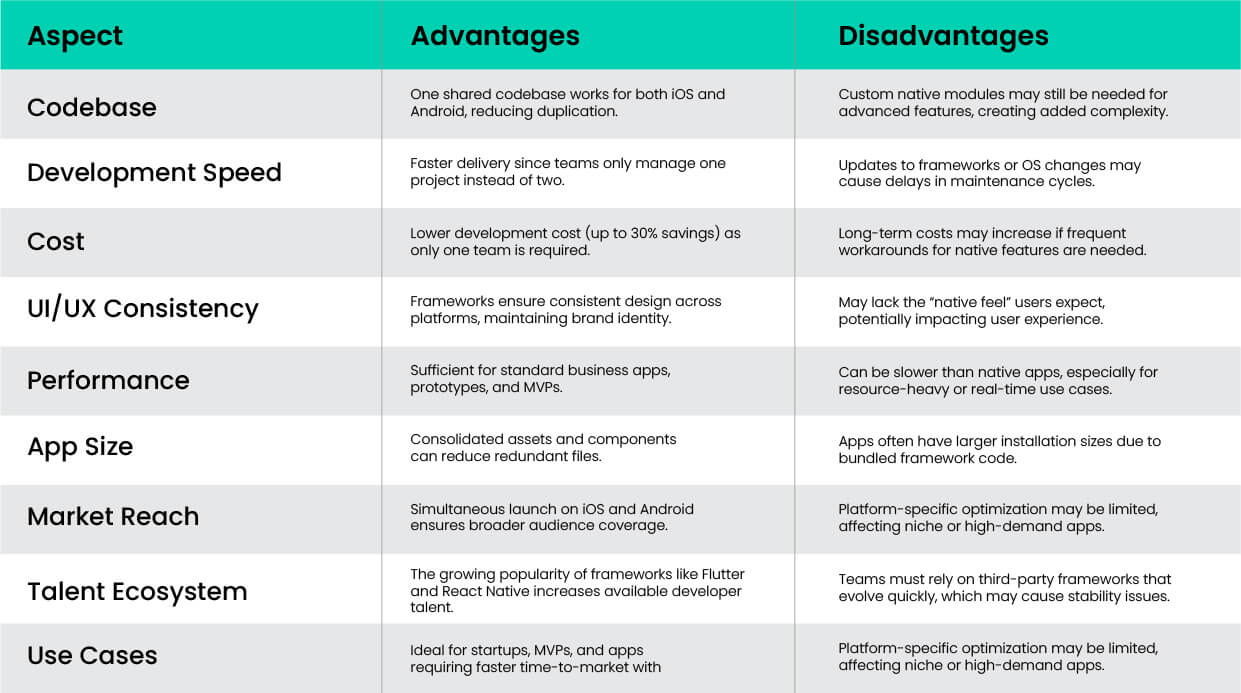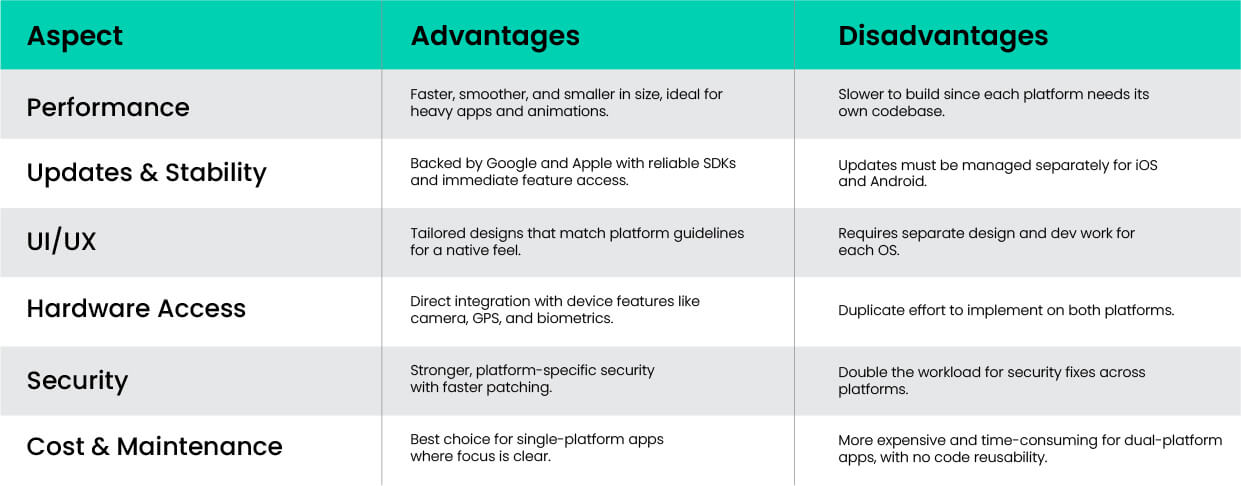Cross-Platform vs Native: Which App Development Approach Fits Your Goals?

Smartphones and tablets have become gateways to commerce, entertainment, and information, seamlessly integrated into everyday life. The market continues to grow according to Similarweb, nearly 64% of all traffic was mobile in 2023, reflecting a steady upward trend over the past decade.
As of 2022, about 1.85 million apps were available in the iOS App Store and 2.56 million in the Google Play Store. A significant portion of these applications is built for both iOS and Android, with a small share extending to other platforms like KaiOS and Huawei’s HarmonyOS. This scale underscores how central mobile apps have become in shaping digital interactions.
Businesses have recognized that mobile touchpoints are among the most effective ways to reach and engage customers. For those considering launching their own app, the decision often narrows to two primary paths: cross-platform or native app development. Each option carries its own set of strengths and challenges, influencing everything from performance and cost to user experience and scalability. Providers of cross-platform app development services position themselves as key partners in helping businesses weigh these factors.
In this guide, we’ll explore these two approaches in depth. By examining critical factors like development time, performance, features, and long-term maintenance, we aim to provide a clear comparison to help you determine the best fit for mobile apps.
What is Cross-Platform App Development?
Cross-platform app development refers to the process of creating a single application that can operate seamlessly across multiple platforms, most commonly iOS and Android. Instead of building separate apps for each operating system, developers work with a shared codebase that delivers functionality to both environments.
Given that iOS and Android together account for nearly the entire global market, most organizations, enterprises, and startups naturally aim to launch their apps on both. Cross-platform development makes this possible without duplicating effort, unlike native development, where dedicated teams must build and maintain separate versions for each platform.
This approach is often summarized by the principle “Write Once, Run Everywhere”. By writing reusable code, developers can accelerate delivery while ensuring consistency across devices. The real power comes from modern frameworks, such as React Native, Flutter, and Kotlin Multiplatform, that provide the tools to bridge operating systems efficiently while maintaining performance and user experience.
Cross-Platform App Development: Advantages & Disadvantages

What is Native App Development?
Native app development refers to building applications designed exclusively for a single operating system. Unlike cross-platform approaches that rely on one shared codebase, native development requires separate codebases for each platform you want to target.
For iOS, developers typically use Swift or Objective-C, while Android apps are generally written in Kotlin or Java. Because these apps are created with the platform’s own programming languages and development environments, they are tightly aligned with the device’s hardware and operating system.
This direct integration is where native apps shine. They tend to offer better performance, smoother user experiences, and deeper access to device-specific features compared to cross-platform alternatives. Many companies turn to professionals offering native application development services to ensure their apps take full advantage of platform-specific strengths.
So why choose native development despite the additional effort and higher cost? For businesses focused on delivering a high-performance product, or those planning to launch on just one platform, the native route provides the most optimized and reliable solution.
Native App Development: Advantages & Disadvantages

How to Decide Between Native and Cross-Platform Development: Factor-by-Factor Breakdown
When planning a mobile application, businesses often consider two main routes: native or cross-platform. Each has its own strengths and trade-offs.
To simplify the decision, here’s a structured comparison of key factors that matter most.
1. Performance
Native Apps: Built with languages like Swift, Kotlin, or Java, native apps run directly on their platforms. They deliver excellent speed, fluid animations, and quick response times. For apps with graphics-heavy tasks or advanced processing, native application development services usually provide the most optimized results.
Cross-Platform Apps: Using frameworks such as Flutter or React Native, cross-platform apps achieve solid performance for everyday use. However, the additional framework layer can sometimes affect peak responsiveness, particularly in highly resource-intensive tasks.
2. Development Timeline
Native Apps: Since developers must write separate codebases for iOS and Android, timelines stretch longer. More resources and coordination are needed, which can delay launches.
Cross-Platform Apps: With a single codebase serving both platforms, teams offering cross platform app development services often deliver apps much faster. This makes them the go-to choice for businesses racing to capture market share quickly.
3. Budget
Native Apps: Building and maintaining two apps usually costs more, as it requires two sets of developers. This higher expense is often justified for apps that demand maximum performance and deep platform integration.
Cross-Platform Apps: By sharing the bulk of the code, cross-platform app development allow businesses to save up to 30–40% in development costs, making this path especially attractive to startups and organizations with limited budgets.
4. User Experience
Native Apps: Native development uses platform-specific UI components, resulting in an experience that feels natural and familiar to users. Native application development services excel at creating pixel-perfect, platform-aligned interfaces.
Cross-Platform Apps: Modern frameworks have improved UI capabilities, but achieving the same level of polish as native apps can be challenging. Minor differences in behavior or styling sometimes stand out.
5. Access to Platform Features
Native Apps: Native code grants developers immediate and complete access to APIs and device-level features, from ARKit on iOS to advanced Android sensors. This allows for quicker adoption of the latest OS updates.
Cross-Platform Apps: While frameworks cover most common features, developers may need plugins or extra modules to unlock platform-specific tools. Delays in framework updates can sometimes slow access to new OS functionalities.
6. Maintenance
Native Apps: Supporting two separate codebases means bug fixes, patches, and updates need to be handled individually. This can increase both time and long-term costs.
Cross-Platform Apps: Maintenance is much simpler, as changes applied to one codebase roll out to all platforms at once. This makes ongoing support more efficient and less resource-intensive.
7. Talent and Ecosystem
Native Apps: Established languages like Swift and Kotlin boast strong ecosystems and large developer communities. Businesses that use native application development services can rely on deep expertise and robust platform support.
Cross-Platform Apps: Frameworks such as React Native and Flutter are growing rapidly, with expanding communities and tooling. Teams providing cross-platform app development services are becoming more common, giving businesses more flexibility.
When to Go with Native App Development
Not every project benefits equally from cross-platform efficiency. In certain cases, investing in native application development services is the smarter long-term choice. Some of the most common scenarios include:
- High-performance apps: If your project involves complex calculations, heavy graphics rendering, or demanding real-time interactions (e.g., mobile games, AR/VR, or advanced video editing tools), native development ensures maximum responsiveness.
- Deep platform integration: Applications that rely on iOS-specific features like Face ID or Android-specific design standards benefit from native frameworks, which allow direct use of the latest APIs without delays.
- Advanced UI/UX needs: Apps requiring highly polished visuals, custom animations, or intricate interaction patterns are better supported with native code, which gives developers complete creative freedom.
- Scalability for growth: If you expect your app to expand in complexity or functionality over time, native development offers a more stable foundation for scaling without sacrificing speed or quality.
- Stricter security requirements: Financial services, healthcare solutions, or enterprise apps dealing with sensitive data often rely on the stronger security layers available through native development.
- Better app store visibility: Native apps often achieve better rankings in app stores, leveraging platform-specific optimizations that help with discoverability and promotion.
When Cross-Platform Development Makes More Sense
For many businesses, especially startups and mid-sized companies, cross-platform app development services provide the ideal balance of cost, speed, and reach.
These are some of the use cases where this path is most effective:
- Budget-conscious projects: If resources are limited, cross-platform development reduces the need for two separate teams by relying on a shared codebase for iOS and Android.
- Accelerated launches: Businesses aiming to capture both iOS and Android audiences quickly often favor cross-platform deployments because they have faster deployment cycles.
- Testing ideas with MVPs: Companies building a minimum viable product can launch faster and more affordably while still reaching a broad user base.
- Consistent branding: A single design system across platforms ensures a uniform brand presence, which is ideal for apps that must look and feel the same everywhere.
- Regular updates: When apps require frequent updates, cross-platform frameworks simplify the process since developers only need to adjust one codebase.
- Moderate performance needs: Apps with standard features (such as e-commerce, content delivery, or social interaction) run effectively cross-platform without noticeable differences for users.
- Broad user reach: For businesses whose primary goal is maximum distribution, launching simultaneously on iOS and Android through one codebase helps capture the widest possible audience.
Wrap Up
The choice between cross-platform and native app development is not about which method is universally better; it’s about which best aligns with your organization’s goals, budget, and technical requirements. Both approaches bring clear advantages and trade-offs that can shape the success of your mobile app.
Cross-platform app development services stand out for businesses seeking cost efficiency, faster time-to-market, and broader user reach. Startups, small enterprises, and companies looking to validate ideas quickly often benefit from this route.
On the other hand, native application development services excel when performance, security, and platform-specific functionality are top priorities. For apps that require advanced features, complex UI/UX, or tight integration with device hardware, native development provides unmatched control and reliability. Ultimately, the decision depends on your app’s complexity, target audience, and growth ambitions. By partnering with Amrood Labs, you gain access to expert guidance and tailored solutions that ensure your mobile app delivers long-term value and impact.



